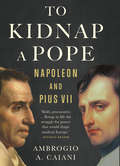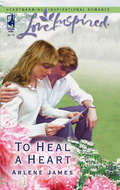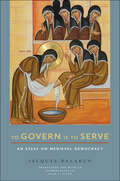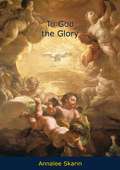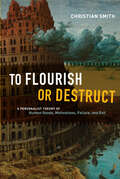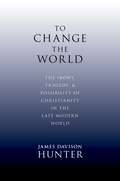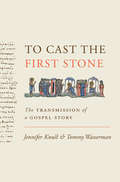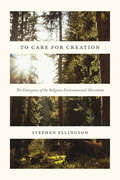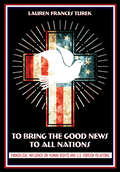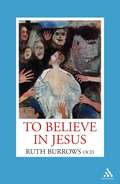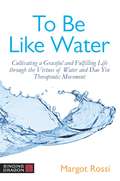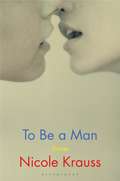- Table View
- List View
To Kidnap a Pope: Napoleon and Pius VII
by Ambrogio A. CaianiA groundbreaking account of Napoleon Bonaparte, Pope Pius VII, and the kidnapping that would forever divide church and state In the wake of the French Revolution, Napoleon Bonaparte, First Consul of France, and Pope Pius VII shared a common goal: to reconcile the church with the state. But while they were able to work together initially, formalizing an agreement in 1801, relations between them rapidly deteriorated. In 1809, Napoleon ordered the Pope’s arrest. Ambrogio Caiani provides a pioneering account of the tempestuous relationship between the emperor and his most unyielding opponent. Drawing on original findings in the Vatican and other European archives, Caiani uncovers the nature of Catholic resistance against Napoleon’s empire; charts Napoleon’s approach to Papal power; and reveals how the Emperor attempted to subjugate the church to his vision of modernity. Gripping and vivid, this book shows the struggle for supremacy between two great individuals—and sheds new light on the conflict that would shape relations between the Catholic church and the modern state for centuries to come.
To Heal a Heart (Mills And Boon Love Inspired Ser.)
by Arlene JamesWhile hurrying to catch a plane, widowed lawyer Mitch Sayer finds a single page from a handwritten letter, a letter offering forgiveness to an unknown recipient.
To Govern Is to Serve: An Essay on Medieval Democracy (Medieval Societies, Religions, and Cultures)
by Jacques DalarunTo Govern Is to Serve explores the practices of collective governance in medieval religious orders that turned the precepts of the Gospels—most notably that "the first will be last, the last will be first"—into practices of communal deliberation and the election of superiors. Jacques Dalarun argues that these democratic forms have profoundly influenced modern experiences of democracy, in particular the idea of government not as domination but as service. Dalarun undertakes meticulous textual analysis and historical research into twelfth and thirteenth-century religious movements—from Fontevraud and the Paraclete of Abelard and Heloise through St. Dominic and St. Francis—that sought their superiors from among the less exalted members of their communities to chart how these experiments prefigured certain aspects of modern democracies, those allowing individuals to find their way forward as part of a collective. Wide ranging and deeply original,To Govern Is to Serve highlights the history of the reciprocal bonds of service and humility that underpin increasingly fragile democracies in the twenty-first century.
To God the Glory
by Annalee SkarinIn the words and teachings of Jesus, TO GOD THE GLORY is a divinely inspired message revealing how His great love is being poured out in abundance and can, if man will accept it, change his life and lead him into His Kingdom.“Behold, I, Jesus Christ, the Alpha and Omega, the Beginning and the End, the Great Amen, have commanded Annalee Skarin to write these, my words, and to send them forth unto the ends of the earth, that, you, who know my voice might be prepared to enter into the New Day—that you might be purified even as I Am pure. For this is my commandment unto you, and I give no commandment save I prepare the way for its fulfillment.“This work is given that all my holy promises might begin to be made manifest in very deed, yea, that they might begin to be fulfilled in you, for the time is at hand, even the great day of preparation, the day of Almighty God the Father.”—Annalee Skarin
To Flourish or Destruct: A Personalist Theory of Human Goods, Motivations, Failure, and Evil
by Christian SmithIn his 2010 book What Is a Person?, Christian Smith argued that sociology had for too long neglected this fundamental question. Prevailing social theories, he wrote, do not adequately “capture our deep subjective experience as persons, crucial dimensions of the richness of our own lived lives, what thinkers in previous ages might have called our ‘souls’ or ‘hearts.’” Building on Smith’s previous work, To Flourish or Destruct examines the motivations intrinsic to this subjective experience: Why do people do what they do? How can we explain the activity that gives rise to all human social life and social structures? Smith argues that our actions stem from a motivation to realize what he calls natural human goods: ends that are, by nature, constitutionally good for all human beings. He goes on to explore the ways we can and do fail to realize these ends—a failure that can result in varying gradations of evil. Rooted in critical realism and informed by work in philosophy, psychology, and other fields, Smith’s ambitious book situates the idea of personhood at the center of our attempts to understand how we might shape good human lives and societies.
To Flourish or Destruct: A Personalist Theory of Human Goods, Motivations, Failure, and Evil
by Christian SmithIn his 2010 book What Is a Person?, Christian Smith argued that sociology had for too long neglected this fundamental question. Prevailing social theories, he wrote, do not adequately “capture our deep subjective experience as persons, crucial dimensions of the richness of our own lived lives, what thinkers in previous ages might have called our ‘souls’ or ‘hearts.’” Building on Smith’s previous work, To Flourish or Destruct examines the motivations intrinsic to this subjective experience: Why do people do what they do? How can we explain the activity that gives rise to all human social life and social structures? Smith argues that our actions stem from a motivation to realize what he calls natural human goods: ends that are, by nature, constitutionally good for all human beings. He goes on to explore the ways we can and do fail to realize these ends—a failure that can result in varying gradations of evil. Rooted in critical realism and informed by work in philosophy, psychology, and other fields, Smith’s ambitious book situates the idea of personhood at the center of our attempts to understand how we might shape good human lives and societies.
To Flourish or Destruct: A Personalist Theory of Human Goods, Motivations, Failure, and Evil
by Christian SmithIn his 2010 book What Is a Person?, Christian Smith argued that sociology had for too long neglected this fundamental question. Prevailing social theories, he wrote, do not adequately “capture our deep subjective experience as persons, crucial dimensions of the richness of our own lived lives, what thinkers in previous ages might have called our ‘souls’ or ‘hearts.’” Building on Smith’s previous work, To Flourish or Destruct examines the motivations intrinsic to this subjective experience: Why do people do what they do? How can we explain the activity that gives rise to all human social life and social structures? Smith argues that our actions stem from a motivation to realize what he calls natural human goods: ends that are, by nature, constitutionally good for all human beings. He goes on to explore the ways we can and do fail to realize these ends—a failure that can result in varying gradations of evil. Rooted in critical realism and informed by work in philosophy, psychology, and other fields, Smith’s ambitious book situates the idea of personhood at the center of our attempts to understand how we might shape good human lives and societies.
To Flourish or Destruct: A Personalist Theory of Human Goods, Motivations, Failure, and Evil
by Christian SmithIn his 2010 book What Is a Person?, Christian Smith argued that sociology had for too long neglected this fundamental question. Prevailing social theories, he wrote, do not adequately “capture our deep subjective experience as persons, crucial dimensions of the richness of our own lived lives, what thinkers in previous ages might have called our ‘souls’ or ‘hearts.’” Building on Smith’s previous work, To Flourish or Destruct examines the motivations intrinsic to this subjective experience: Why do people do what they do? How can we explain the activity that gives rise to all human social life and social structures? Smith argues that our actions stem from a motivation to realize what he calls natural human goods: ends that are, by nature, constitutionally good for all human beings. He goes on to explore the ways we can and do fail to realize these ends—a failure that can result in varying gradations of evil. Rooted in critical realism and informed by work in philosophy, psychology, and other fields, Smith’s ambitious book situates the idea of personhood at the center of our attempts to understand how we might shape good human lives and societies.
To Flourish or Destruct: A Personalist Theory of Human Goods, Motivations, Failure, and Evil
by Christian SmithIn his 2010 book What Is a Person?, Christian Smith argued that sociology had for too long neglected this fundamental question. Prevailing social theories, he wrote, do not adequately “capture our deep subjective experience as persons, crucial dimensions of the richness of our own lived lives, what thinkers in previous ages might have called our ‘souls’ or ‘hearts.’” Building on Smith’s previous work, To Flourish or Destruct examines the motivations intrinsic to this subjective experience: Why do people do what they do? How can we explain the activity that gives rise to all human social life and social structures? Smith argues that our actions stem from a motivation to realize what he calls natural human goods: ends that are, by nature, constitutionally good for all human beings. He goes on to explore the ways we can and do fail to realize these ends—a failure that can result in varying gradations of evil. Rooted in critical realism and informed by work in philosophy, psychology, and other fields, Smith’s ambitious book situates the idea of personhood at the center of our attempts to understand how we might shape good human lives and societies.
To Flourish or Destruct: A Personalist Theory of Human Goods, Motivations, Failure, and Evil
by Christian SmithIn his 2010 book What Is a Person?, Christian Smith argued that sociology had for too long neglected this fundamental question. Prevailing social theories, he wrote, do not adequately “capture our deep subjective experience as persons, crucial dimensions of the richness of our own lived lives, what thinkers in previous ages might have called our ‘souls’ or ‘hearts.’” Building on Smith’s previous work, To Flourish or Destruct examines the motivations intrinsic to this subjective experience: Why do people do what they do? How can we explain the activity that gives rise to all human social life and social structures? Smith argues that our actions stem from a motivation to realize what he calls natural human goods: ends that are, by nature, constitutionally good for all human beings. He goes on to explore the ways we can and do fail to realize these ends—a failure that can result in varying gradations of evil. Rooted in critical realism and informed by work in philosophy, psychology, and other fields, Smith’s ambitious book situates the idea of personhood at the center of our attempts to understand how we might shape good human lives and societies.
To Change the World: The Irony, Tragedy, and Possibility of Christianity in the Late Modern World
by James Davison HunterThe call to make the world a better place is inherent in the Christian belief and practice. But why have efforts to change the world by Christians so often failed or gone tragically awry? And how might Christians in the 21st century live in ways that have integrity with their traditions and are more truly transformative? In To Change the World, James Davison Hunter offers persuasive--and provocative--answers to these questions. Hunter begins with a penetrating appraisal of the most popular models of world-changing among Christians today, highlighting the ways they are inherently flawed and therefore incapable of generating the change to which they aspire. Because change implies power, all Christian eventually embrace strategies of political engagement. Hunter offers a trenchant critique of the political theologies of the Christian Right and Left and the Neo-Anabaptists, taking on many respected leaders, from Charles Colson to Jim Wallis and Stanley Hauerwas. Hunter argues that all too often these political theologies worsen the very problems they are designed to solve. What is really needed is a different paradigm of Christian engagement with the world, one that Hunter calls "faithful presence"--an ideal of Christian practice that is not only individual but institutional; a model that plays out not only in all relationships but in our work and all spheres of social life. He offers real-life examples, large and small, of what can be accomplished through the practice of "faithful presence." Such practices will be more fruitful, Hunter argues, more exemplary, and more deeply transfiguring than any more overtly ambitious attempts can ever be. Written with keen insight, deep faith, and profound historical grasp, To Change the World will forever change the way Christians view and talk about their role in the modern world.
To Change the World: The Irony, Tragedy, and Possibility of Christianity in the Late Modern World
by James Davison HunterThe call to make the world a better place is inherent in the Christian belief and practice. But why have efforts to change the world by Christians so often failed or gone tragically awry? And how might Christians in the 21st century live in ways that have integrity with their traditions and are more truly transformative? In To Change the World, James Davison Hunter offers persuasive--and provocative--answers to these questions. Hunter begins with a penetrating appraisal of the most popular models of world-changing among Christians today, highlighting the ways they are inherently flawed and therefore incapable of generating the change to which they aspire. Because change implies power, all Christian eventually embrace strategies of political engagement. Hunter offers a trenchant critique of the political theologies of the Christian Right and Left and the Neo-Anabaptists, taking on many respected leaders, from Charles Colson to Jim Wallis and Stanley Hauerwas. Hunter argues that all too often these political theologies worsen the very problems they are designed to solve. What is really needed is a different paradigm of Christian engagement with the world, one that Hunter calls "faithful presence"--an ideal of Christian practice that is not only individual but institutional; a model that plays out not only in all relationships but in our work and all spheres of social life. He offers real-life examples, large and small, of what can be accomplished through the practice of "faithful presence." Such practices will be more fruitful, Hunter argues, more exemplary, and more deeply transfiguring than any more overtly ambitious attempts can ever be. Written with keen insight, deep faith, and profound historical grasp, To Change the World will forever change the way Christians view and talk about their role in the modern world.
To Cast the First Stone: The Transmission of a Gospel Story
by Jennifer Knust Tommy WassermanThe story of the woman taken in adultery features a dramatic confrontation between Jesus and the Pharisees over whether the adulteress should be stoned as the law commands. In response, Jesus famously states, “Let him who is without sin be the first to throw a stone at her.” To Cast the First Stone traces the history of this provocative story from its first appearance to its enduring presence today.Likely added to the Gospel of John in the third century, the passage is often held up by modern critics as an example of textual corruption by early Christian scribes and editors, yet a judgment of corruption obscures the warm embrace the story actually received. Jennifer Knust and Tommy Wasserman trace the story’s incorporation into Gospel books, liturgical practices, storytelling, and art, overturning the mistaken perception that it was either peripheral or suppressed, even in the Greek East. The authors also explore the story’s many different meanings. Taken as an illustration of the expansiveness of Christ’s mercy, the purported superiority of Christians over Jews, the necessity of penance, and more, this vivid episode has invited any number of creative receptions. This history reveals as much about the changing priorities of audiences, scribes, editors, and scholars as it does about an “original” text of John.To Cast the First Stone calls attention to significant shifts in Christian book cultures and the enduring impact of oral tradition on the preservation—and destabilization—of scripture.
To Cast the First Stone: The Transmission of a Gospel Story
by Jennifer Knust Tommy WassermanThe story of the woman taken in adultery features a dramatic confrontation between Jesus and the Pharisees over whether the adulteress should be stoned as the law commands. In response, Jesus famously states, “Let him who is without sin be the first to throw a stone at her.” To Cast the First Stone traces the history of this provocative story from its first appearance to its enduring presence today.Likely added to the Gospel of John in the third century, the passage is often held up by modern critics as an example of textual corruption by early Christian scribes and editors, yet a judgment of corruption obscures the warm embrace the story actually received. Jennifer Knust and Tommy Wasserman trace the story’s incorporation into Gospel books, liturgical practices, storytelling, and art, overturning the mistaken perception that it was either peripheral or suppressed, even in the Greek East. The authors also explore the story’s many different meanings. Taken as an illustration of the expansiveness of Christ’s mercy, the purported superiority of Christians over Jews, the necessity of penance, and more, this vivid episode has invited any number of creative receptions. This history reveals as much about the changing priorities of audiences, scribes, editors, and scholars as it does about an “original” text of John.To Cast the First Stone calls attention to significant shifts in Christian book cultures and the enduring impact of oral tradition on the preservation—and destabilization—of scripture.
To Care for Creation: The Emergence of the Religious Environmental Movement
by Stephen EllingsonControversial megachurch pastor Mark Driscoll proclaimed from a conference stage in 2013, “I know who made the environment and he’s coming back and going to burn it all up. So yes, I drive an SUV.” The comment, which Driscoll later explained away as a joke, highlights what has been a long history of religious anti-environmentalism. Given how firmly entrenched this sentiment has been, surprising inroads have been made by a new movement with few financial resources, which is deeply committed to promoting green religious traditions and creating a new environmental ethic. To Care for Creation chronicles this movement and explains how it has emerged despite institutional and cultural barriers, as well as the hurdles posed by logic and practices that set religious environmental organizations apart from the secular movement. Ellingson takes a deep dive into the ways entrepreneurial activists tap into and improvise on a variety of theological, ethical, and symbolic traditions in order to issue a compelling call to arms that mobilizes religious audiences. Drawing on interviews with the leaders of more than sixty of these organizations, Ellingson deftly illustrates how activists borrow and rework resources from various traditions to create new meanings for religion, nature, and the religious person’s duty to the natural world.
To Care for Creation: The Emergence of the Religious Environmental Movement
by Stephen EllingsonControversial megachurch pastor Mark Driscoll proclaimed from a conference stage in 2013, “I know who made the environment and he’s coming back and going to burn it all up. So yes, I drive an SUV.” The comment, which Driscoll later explained away as a joke, highlights what has been a long history of religious anti-environmentalism. Given how firmly entrenched this sentiment has been, surprising inroads have been made by a new movement with few financial resources, which is deeply committed to promoting green religious traditions and creating a new environmental ethic. To Care for Creation chronicles this movement and explains how it has emerged despite institutional and cultural barriers, as well as the hurdles posed by logic and practices that set religious environmental organizations apart from the secular movement. Ellingson takes a deep dive into the ways entrepreneurial activists tap into and improvise on a variety of theological, ethical, and symbolic traditions in order to issue a compelling call to arms that mobilizes religious audiences. Drawing on interviews with the leaders of more than sixty of these organizations, Ellingson deftly illustrates how activists borrow and rework resources from various traditions to create new meanings for religion, nature, and the religious person’s duty to the natural world.
To Care for Creation: The Emergence of the Religious Environmental Movement
by Stephen EllingsonControversial megachurch pastor Mark Driscoll proclaimed from a conference stage in 2013, “I know who made the environment and he’s coming back and going to burn it all up. So yes, I drive an SUV.” The comment, which Driscoll later explained away as a joke, highlights what has been a long history of religious anti-environmentalism. Given how firmly entrenched this sentiment has been, surprising inroads have been made by a new movement with few financial resources, which is deeply committed to promoting green religious traditions and creating a new environmental ethic. To Care for Creation chronicles this movement and explains how it has emerged despite institutional and cultural barriers, as well as the hurdles posed by logic and practices that set religious environmental organizations apart from the secular movement. Ellingson takes a deep dive into the ways entrepreneurial activists tap into and improvise on a variety of theological, ethical, and symbolic traditions in order to issue a compelling call to arms that mobilizes religious audiences. Drawing on interviews with the leaders of more than sixty of these organizations, Ellingson deftly illustrates how activists borrow and rework resources from various traditions to create new meanings for religion, nature, and the religious person’s duty to the natural world.
To Care for Creation: The Emergence of the Religious Environmental Movement
by Stephen EllingsonControversial megachurch pastor Mark Driscoll proclaimed from a conference stage in 2013, “I know who made the environment and he’s coming back and going to burn it all up. So yes, I drive an SUV.” The comment, which Driscoll later explained away as a joke, highlights what has been a long history of religious anti-environmentalism. Given how firmly entrenched this sentiment has been, surprising inroads have been made by a new movement with few financial resources, which is deeply committed to promoting green religious traditions and creating a new environmental ethic. To Care for Creation chronicles this movement and explains how it has emerged despite institutional and cultural barriers, as well as the hurdles posed by logic and practices that set religious environmental organizations apart from the secular movement. Ellingson takes a deep dive into the ways entrepreneurial activists tap into and improvise on a variety of theological, ethical, and symbolic traditions in order to issue a compelling call to arms that mobilizes religious audiences. Drawing on interviews with the leaders of more than sixty of these organizations, Ellingson deftly illustrates how activists borrow and rework resources from various traditions to create new meanings for religion, nature, and the religious person’s duty to the natural world.
To Care for Creation: The Emergence of the Religious Environmental Movement
by Stephen EllingsonControversial megachurch pastor Mark Driscoll proclaimed from a conference stage in 2013, “I know who made the environment and he’s coming back and going to burn it all up. So yes, I drive an SUV.” The comment, which Driscoll later explained away as a joke, highlights what has been a long history of religious anti-environmentalism. Given how firmly entrenched this sentiment has been, surprising inroads have been made by a new movement with few financial resources, which is deeply committed to promoting green religious traditions and creating a new environmental ethic. To Care for Creation chronicles this movement and explains how it has emerged despite institutional and cultural barriers, as well as the hurdles posed by logic and practices that set religious environmental organizations apart from the secular movement. Ellingson takes a deep dive into the ways entrepreneurial activists tap into and improvise on a variety of theological, ethical, and symbolic traditions in order to issue a compelling call to arms that mobilizes religious audiences. Drawing on interviews with the leaders of more than sixty of these organizations, Ellingson deftly illustrates how activists borrow and rework resources from various traditions to create new meanings for religion, nature, and the religious person’s duty to the natural world.
To Care for Creation: The Emergence of the Religious Environmental Movement
by Stephen EllingsonControversial megachurch pastor Mark Driscoll proclaimed from a conference stage in 2013, “I know who made the environment and he’s coming back and going to burn it all up. So yes, I drive an SUV.” The comment, which Driscoll later explained away as a joke, highlights what has been a long history of religious anti-environmentalism. Given how firmly entrenched this sentiment has been, surprising inroads have been made by a new movement with few financial resources, which is deeply committed to promoting green religious traditions and creating a new environmental ethic. To Care for Creation chronicles this movement and explains how it has emerged despite institutional and cultural barriers, as well as the hurdles posed by logic and practices that set religious environmental organizations apart from the secular movement. Ellingson takes a deep dive into the ways entrepreneurial activists tap into and improvise on a variety of theological, ethical, and symbolic traditions in order to issue a compelling call to arms that mobilizes religious audiences. Drawing on interviews with the leaders of more than sixty of these organizations, Ellingson deftly illustrates how activists borrow and rework resources from various traditions to create new meanings for religion, nature, and the religious person’s duty to the natural world.
To Bring the Good News to All Nations: Evangelical Influence on Human Rights and U.S. Foreign Relations (The United States in the World)
by Lauren Frances TurekWhen American evangelicals flocked to Latin America, Africa, Asia, and Eastern Europe in the late twentieth century to fulfill their Biblical mandate for global evangelism, their experiences abroad led them to engage more deeply in foreign policy activism at home. Lauren Frances Turek tracks these trends and illuminates the complex and significant ways in which religion shaped America's role in the late–Cold War world. In To Bring the Good News to All Nations, she examines the growth and influence of Christian foreign policy lobbying groups in the United States beginning in the 1970s, assesses the effectiveness of Christian efforts to attain foreign aid for favored regimes, and considers how those same groups promoted the imposition of economic and diplomatic sanctions on those nations that stifled evangelism.Using archival materials from both religious and government sources, To Bring the Good News to All Nations links the development of evangelical foreign policy lobbying to the overseas missionary agenda. Turek's case studies—Guatemala, South Africa, and the Soviet Union—reveal the extent of Christian influence on American foreign policy from the late 1970s through the 1990s. Evangelical policy work also reshaped the lives of Christians overseas and contributed to a reorientation of U.S. human rights policy. Efforts to promote global evangelism and support foreign brethren led activists to push Congress to grant aid to favored, yet repressive, regimes in countries such as Guatemala while imposing economic and diplomatic sanctions on nations that persecuted Christians, such as the Soviet Union. This advocacy shifted the definitions and priorities of U.S. human rights policies with lasting repercussions that can be traced into the twenty-first century.
To Believe in Jesus
by Ruth Burrows OcdThe message of To Believe in Jesus is heartening, if disconcerting, for it stands a common assumption on its head.The way to holiness is not through dramatic renunciation, and holiness itself is not just for the 'specialists', clergy and religious. Holiness cannot be struggled for and won - it can only be given, and all that is necessary is that we should ask. As soon as we cease to strive for virtue, concentrating attention uselessly on ourselves, and instead recognise our weakness, our need, the way is open to encounter God and the holiness of Jesus which is His gift.
To Be Like Water: Cultivating a Graceful and Fulfilling Life through the Virtues of Water and Dao Yin Therapeutic Movement
by Margot RossiDrawing on South and East Asian philosophies and medicines, this book illustrates how our bodies and minds are influenced by our actions, habits, aging, trauma and thought patterns. Using the analogy of being like water, Margot Rossi presents a range of practices - including imagery, Daoyin therapeutic movement, yoga and mindful attention - that help build awareness and potentially shift our form, physiologically and neurologically.The first section of the book is dedicated to exploring the virtues of being like water, based on 30 years of Rossi's professional and personal experience. Each essay ends with Daoyin therapeutic movements, learned and interpreted from the oral teachings of 88th-generation Daoist master Jeffrey Yuen. The second section offers teachings of Classical Chinese Medicine theory for patients and practitioners alike. It includes detailed case studies, basic diagnostic steps and demonstrates how health concerns can be used as a foundation for change and growth.
To Be Like Water: Cultivating a Graceful and Fulfilling Life through the Virtues of Water and Dao Yin Therapeutic Movement
by Margot RossiDrawing on South and East Asian philosophies and medicines, this book illustrates how our bodies and minds are influenced by our actions, habits, aging, trauma and thought patterns. Using the analogy of being like water, Margot Rossi presents a range of practices - including imagery, Daoyin therapeutic movement, yoga and mindful attention - that help build awareness and potentially shift our form, physiologically and neurologically.The first section of the book is dedicated to exploring the virtues of being like water, based on 30 years of Rossi's professional and personal experience. Each essay ends with Daoyin therapeutic movements, learned and interpreted from the oral teachings of 88th-generation Daoist master Jeffrey Yuen. The second section offers teachings of Classical Chinese Medicine theory for patients and practitioners alike. It includes detailed case studies, basic diagnostic steps and demonstrates how health concerns can be used as a foundation for change and growth.
To Be a Man: 'One of America's most important novelists' (New York Times)
by Nicole KraussAn electrifying short story collection from 'one of America's most important novelists' (New York Times); the twice Orange Prize-shortlisted author of the bestselling The History of Love 'One of our most formidable talents in fiction' ESQUIRE'Krauss's writing is as lyrical as ever' FINANCIAL TIMESDeftly weaving from one end of life to another – from ageing parents to newborn babies, from a young girl's coming-of-age to an old woman's unexpected delivery of a strange new second youth, from mystery and wonder at a life at its close or at a future waiting to unfold, Nicole Krauss's stories illuminate the moments in the lives of women in which the forces of sex, power and violence collide.With sons and lovers, seducers and friends, husbands lost and regained, or husbands who were never husbands at all, how many men does can a woman's lifetime hold? What does it mean to be a man and a woman together; or a man and a woman, once together and now apart?Beautiful, taut and dark, spinning across the world, from Switzerland, Japan and New York to Tel Aviv, Los Angeles and South America, To Be a Man delves with originality and timeliness into questions of masculinity and violence, regret and regeneration, control and desire; and shines a fierce, unwavering light onto men and women, and into the uncharted gulfs that lie between them.
